The Wavendon Arm (once The Leathern Bottel)
The name of this inn has fluctuated between ‘Leather’ and ‘Leathern’, as well as ‘Bottle’, ‘Bottel’ and ‘Bottell’. Unless directly quoting from archival sources, I will stick to Leathern Bottle. Apart from those spelling variations, it is unusual in the area, as it had the same name throughout its early history, until it changed (reasonably recently) to the Wavendon Arms.
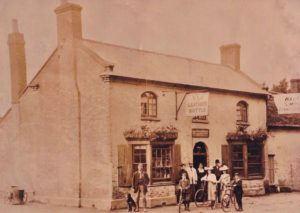
The early deeds are probably with Mitchells & Butlers Plc., the current owners, but they have not responded to my requests for access or assistance.
As with most local pubs, it can be traced back as far as 1753, but the current building is certainly not of that age. It must have been rebuilt at some point, and the date 1851 is used on a website by the company now operating the business, so perhaps they have evidence of that being the date of the ‘modern’ building, or that is as far back as the deeds go to which they have access.
Much of Wavendon was once owned by the Hoare banking family, which founded Hoare’s Bank in London in 1672. It is interesting to note that the early sign for the Bank, hung outside their premises in Goldsmith’s Row, not far from the Bank of England, was a gilded leather bottle. In 1690, they moved to Fleet Street and took their sign with them. Whether this can be connected to the name of an inn on their estate in rural Buckinghamshire is open for debate, but it would be a nice connection to think so.
When the Bucks Alehouse Register opens in 1753, an inn at Wavendon called the Leather Bottle is being run by Ann Cave. She continues (sometimes recorded as Caves) up to 1769 when a Thomas Holme appears. His name also gains an ‘s’ from 1773 onwards. After 19 years, he is followed in 1788 by a William Holmes. William outlasts his father(?) and stays 21 years, until 1808. The name John Barett is given in 1809, but then John Bennett appears 1810-1825, so I think that first instance is probably an error by the court clerk. In 1826, the name Mattius Mole is given for just that one year, followed by William Rogers in 1827, the last year available in the Bucks Alehouse Register.
By that time, local press adverts and reports had started to mention the inn. As a principle inn in the area, on a main road, it was a place that people would know to navigate by. As well as staging local auctions, it was also a place to obtain local auction particulars for other local from. It was listed as such in a June 1819 edition of the Northampton Mercury, along with The Goat at Woburn, The Bull at Hockliffe and all the inns in Cranfield when a large estate at Cranfield was put up for sale.
In the Bucks Herald of 9th May 1925, there is a long recount of the life of soldier Captain David Augustus Smith, originally from nearby Loughton. A columnist (who signed the piece as “Tau”), describes the life of Smith, born in 1772, and how he fought at the Battle of Corunna in 1809, where British troops were being evacuated from Northern Spain, while retreating from the French army in the Peninsula War. From 1814, he was stationed in Ireland, but in early 1819, his unit, the 20th Regt. of Foot, was on route to a posting at St Helena in the South Atlantic Ocean, when Smith was taken ill. He turned back at Madeira and returned to England, and it is presumed he was travelling home to Loughton when his illness worsened and he was forced to stop at Wavendon. His will was written on 6th August, witnessed by Thomas Higgs (possibly the landlord of the Red House inn, nearby) and Henry Lucas. He must have known he was dying, and appointed a surgeon of Woburn and the Rector of Wavendon as his Executors. Tau says that Smith died at the Leathern Bottle on 30th August. There is no indication of where the writer got this story from, and I have not been able to verify it.
An advert was run in the Northampton Mercury of 5th November 1825, for an auction at the Leathern Bottle of all the belongings of an existing landlord of the inn itself:
“To be SOLD by AUCTION, By Andrew Gardner, On Tuesday next, November the 8th, 1825, The useful HOUSEHOLD FURNITURE, GLASS, EARTHERNWARE, and other EFFECTS, on the Premises of Mr. JOHN BENNET, at HOGSTY-END, Bucks, who has Left the Leather-Bottle Public House, Wavendon, and has now taken the Duke of Wellington Inn, near to the Green Man Inn, Barnet, Hertfordshire; comprising two four-post, one tent, and one mahogany press Bedsteads, with printed, cotton and stuff furnitures; Mattresses, feather and flock Bed, Blankets, Quilts and Counterpanes; window Curtains, dressing Tables, ditto Glasses, bedside and other carpets; mahogany Night Conveniences, ditto Chest of Drawers, ditto tea Tables, oak dining ditto, pier glass, 30-Hour Clock, walnut-tree Bureau, wheel barometer, kitchen Utensils in general, Glass and Earthenware, two half Pockets of Hops; with a variety of other useful Effects. Sale to begin precisely at Half-past Ten o’clock in the Morning”
Alas, the move did not work out well for him. John Bennett is listed under ‘Insolvent Debtors’ in the London Gazette in March 1827, while still at the Duke of Wellington and Commercial Inn, Barnet.
There is no inn sign given on the first available census that collected personal details, in June 1841, but the last landlord mentioned at the close of the Alehouse Register in 1827 was a William Rogers, and here is a William Rogers listed under Wavendon as a “Publican”, so it would be a fair assumption that this household is the Leathern Bottle. However, from the age given in the census would seem to indicate that this William may have taken over from his father of the same name, a common occurrence in those days. The household now consisted of:
William Rogers, 25, Publican, born in Bucks
Thomas Rogers, 21, born in Bucks
Elizabeth Rogers, 20, born in Bucks
Indeed, the will of William Rogers (snr.) from 1839, noted as a Victualler, is stored at the Centre for Bucks Studies (CBS). It was proved 2nd October 1839, and he left everything to his wife Jane, and then to their children, William, Thomas and Elizabeth Rogers. However, Jane died before William, so a codicil was added redevising all his worldly goods between his children, including lands in Calcutt, Bow Brickhill.
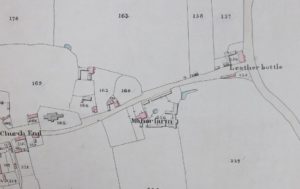
In the Evening Mail of 16th July 1841, a report of the Summer Assizes said John and Robert King, along with Samuel Brazier had been indicted for killing nine sheep belonging to John Howe. In follow-up local reports, William Rogers and his brother Thomas from the Leathern Bottle were both called to give evidence, as the accused had been drinking at the inn the night before the dead sheep were found. After lots of witness statements and conflicting arguments, the men were eventually exonerated.
Yet, a couple of years later, the Rogers family had moved on. From Bell’s Life in London & Sporting Chronicle of 1st October 1843:
“Mr. Emmerton of the Leather Bottle, Wavendon, has backed his pony, named Tiny, only thirty seven inches high, and a boy (his son) only six years old last March, to go ten miles in the hour, for £20. It will come off on the road between the Leather Bottle, Wavendon, and Newport Pagnell, five miles down and back.”
Sadly, I couldn’t find any report of whether the boy succeeded or not! Edward Emmerton appears in the 1847 Kellys Directory, and remained another few years before moving on again, but not very far. The Northampton Mercury of 12th May 1849 advertised:
“SWAN INN, WOBURN SANDS, EDWARD EMMERTON, (From the Leathern Bottle, Wavendon), BEGS most respectfully to inform his Friends and the Public generally that he has TAKEN and ENTERED UPON the above well-known INN, lately occupied by Mr. Thomas Odams, and trusts, by paying strict attention to the comforts of his customers, and keeping in Stock ALES, WINES and SPIRITS of the very best quality, at moderate charges, not only to retain past but to merit increased patronage. Excellent accommodation for Commercial Travellers. Good stabling and lock-up Coach-house Capital dry lairs for drovers &c.”
Yet like John Bennett before, the move turned out to be a bad one for Emmerton. After several run-ins with the law, he was eventually made bankrupt in 1851.
Again, the 1851 Census does not give a sign for the Leathern Bottle, but there is an entry for George Abercrombie, and later records prove this was the Leathern Bottle:
George Abercrombie, 44, Victualler, born Maidenhead
Mary Ann Abercrombie, 40, born Maidenhead
Mary Abercrombie, 13, born Chingford
Elizabeth Abercrombie, 11, born Bonny[?] Bucks.
Sarah Ray, 15, Barmaid, born Maidenhead
George Clerk, 17, Ostler, born Broughton, Bucks.
George Abercrombie appears running the Leathern Bottle in the 1853 Musson & Craven Trade Directory for Wavendon, but he is then listed erroneously as “Charles” in the 1854 Kellys version.
As far as we know, for all the time so far, the inn had been rented out by the Hoare family. The CBS has a surviving deed, dated 21st December 1859, for the lease of the pub. It shows it was owned by the resident of Wavendon House, Henry Arthur Hoare, and he charged Abercrombie £63 p.a. rental for the lease of Public House called “The Leather Bottle” and fields nearby (c.20a. 15p.) The rent was due four instalments through the year. [CBS: D 168/45; also Wiltshire & Swindon History Centre: 383/857]
George Abercrombie wasn’t present on the census night in 1861, as he was away at his nephew’s pub, the Yorkshire Grey, at Stratford, Essex. He was there with Mary his daughter. Perhaps he was helping his nephew with the business, as landlord Jesse Fowler was only 25, but George listed his own profession as “Independent”. Back home in Wavendon, listed at the “Leather Bottle” were:
Mary A. Abercrombie, 49, Innkeepers wife, born Maidenhead
Elizabeth Abercrombie, 21 Assists at Inn, born Bobney[?]
Robert Lagden, lodger, 25, groom, from Bury St Edmunds
Isaac O’Connor, lodger, 25, groom, from Newmarket
The wrong forename was used again in the 1863 Dutton’s Directory, but ‘George’ is used in the 1864 Kellys Directory.
By the time of the 1871 Census, all their children had left home. Listed at the “Leathern Bottle” were just:
George Abercrombie, 63, Publican & farmer, 33 acres, employing 1 man
Mary Ann Abercrombie, 50, Publican & farmers wife
…but Mary Ann died before the year was out, on 22nd December, and was buried at Wavendon. Abercrombie appears in the 1871 Mercer & Crocker Directory, and also the 1872 county-wide Alehouse Survey. The entry for the Leather Bottle shows it was still leased from Henry Hoare. In December the same year, the Bicester Herald reported that: “Peter Moran and James Moran were sentenced to six weeks’ imprisonment each for stealing a crape cloth waistband and a copper warmer, the property of Mr. George Abercrombie, the landlord of the “Leathern Bottle,” at Wavendon.”
On 20th December 1878, George Abercrombie died, and the inn transferred to his son-in-law, William King, of the well-known King family of Wavendon, who were local farmers and maltsters. This is confirmed in a report of a court case in the Bucks Herald of 14th August 1880, brought by Jesse Smith, a grocer, of Fenny Stratford. Smith had delivered goods to William King at the Leathern Bottle worth £12 12s, while King was still assisting Abercrombie, and now King said he was not responsible for paying for them. Obviously, since Abercrombie had died two years before, trying to get money from his estate would prove difficult for Smith. The judge was of the opinion that as no specific mention had been made at the time of ordering of who the goods were for, King should pay for them.
Smith would have been grateful he got in when he did, as by the next month, King relinquished the inn. Croydon’s Weekly Standard, 23rd October 1880: “Transfer of licences. – The following licences were transferred: The Leathern Bottle Inn, Wavendon, from William King to Joseph Partridge.” The next census gives us some more information about Partridge.
Listed under “Leathern Bottle” in the 1881 Census:
Joseph Partridge, Inn Keeper, 56, born Wollaston, Northampton
Sarah Partridge, Wife, 48, Moulton, Northampton
Anne Maria Harris, Niece, 24, Hardington, Northampton
Reuben Clarke, Labourer, 22, Parsonham, Northampton
Henry Griffin, Lodger, Wheelwright, 29, Southwark, Warwick
The next year, the half-yearly audit dinner was held at the Leathern Bottle, and details appeared in the 10th July 1882 Croydon’s Weekly Standard:
“WAVENDON. THE “HOARE” ESTATE. On Monday last, on the occasion of the half-yearly audit, the tenant farmers dined at the old family hostelry, the Leathern Bottle Inn, Wavendon. The chair was taken by Thomas Lane, Esq., the acting trustee for Henry Hugh Arthur Hoare, Esq., and the vice-chair by J. Winner, Esq., of London solicitor to the estate. Nearly twenty sat down to a well supplied dinner, provided by Mr. and Mrs Joseph Partridge, formerly of the Duke’s Head, Deanshanger. The usual loyal and family toasts were proposed and intellectually responded to. The audit dinners are always held at the Leathern Bottle, a county inn, named for its legendary lore, situate as it is under the shadow of the old family mansion of this great house. It is anticipated that the popular young squire, the heir to this ancient and justly revered family, may, if not at the next, at an early audit, dine with the tenantry of his ancestors at this old village inn so closely welded with the annals of the “house of Hoare”.”
As mentioned, this event occurred at the inn regularly, but also sometimes at the Plough. After the report of speeches and toasts at the June 1887 meeting, the Leighton Buzzard Observer noted “The dinner was excellently served up under the superintendence of Mr. and Mrs. Partridge, and the table attended as usual by Miss Harris, their niece. It is no forced flattery to recognise that which is some county inns is rare – the irreproachable neatness, cleanness, and order of the Leathern Bottle dinner tables.”, and again in June 1888 in the Northampton Mercury, “Mr. and Mrs. Partridge provided an excellent dinner, served up with their usual perfection and attentive waiting.”
At CBS, in the policy book of the Sun Fire Office, Stony Stratford branch, there is an entry for the inn. John Partridge insured the Leathern Bottle Inn on 10 May 1882, for £235, and specifically included his “musical instruments, printed music, and mathematical and philosophical instruments & apparatus”. The only thing excepted in the policy was “the plate glass to front”. [CBS D 100/50]
Despite his catering excellence, Partridge had another business on the side. He had also been operating as a wheelwright and blacksmith from the inn, but gave this up the next year. From the Leighton Buzzard Observer, 22nd January 1889:
“LEATHERN BOTTLE INN, WAVENDON, One Mile from Woburn Sands Station, on the Bedford Branch of the L. and N. W. Railway. QUANTITY OF SAWN TIMBER, COMPRISING oak and elm coffin boards, oak and elm plank, and scantling, ash planks and fencing rails, cart sides, spokes, and felloes, hurdles, ladders, slabs, wheelbarrows, &c., &c.; the valuable STOCK -IN-TRADE of a Wheelwright and Smith, a capital pair of blacksmith’s bellows, nearly new; drilling machine, turning lathe, circular hollow shoeing platform by Roberts; FARMIMG IMPLEMENTS, including rick sheet, twelve yards square; 3-inch-wheel cart on iron arms; manure cart, on springs; iron ploughs, harness, scufflers, pulper, by Hunt and Co., chaff-cutting machire and bean mill, by Roberts; iron horse rake, trace and thill harness; capital light spring cart, nearly new, and miscellaneous effects; TO BE SOLD BY AUCTION BY MR. GEO. WIGLEY, ON FRIDAY, THE 25TH OF JANUARY, 1889, on the premises, Leathern Bottle Inn, Wavendon by direction of Mr. Jos. Partridge, who is giving up the wheelwright and blacksmith’s business. The sale will commence at 11 o’clock. Catalogues may be had of Offices of the Auctioneer, Winslow, and Town Hall Offices, Fenny Stratford.”
Four months later, and Partridge was trying to sell off the crops he had grown on the farm attached to the Leathern Bottle. The Leighton Buzzard Observer, May 14th:
“LEATHERN BOTTLE FARM, WAVENDON, One Mile from Woburn Sands Station. 30 Acres of Rich GRASS KEEPING, Up to September 29th, well fenced and watered, in convenient Lots; 20 Acres of capital CLOVER, first year’s ley, first crop to go off; TO BE SOLD BY AUCTION, BY Mr. Geo. WIGLEY ON THURSDAY, MAY THE 16TH, 1889, By direction of Mr. Partridge. Credit will be given till August 1st, on the usual Conditions. The Company will oblige by meeting the Auctioneer at the Leathern Bottle Inn at 5 o’clock. Catalogues may be had of Offices of the Auctioneer, Winslow, and Town Hall Offices, Fenny Stratford.”
That summer, he successfully provided the annual dinner for Mr. Hoare’s tenantry again, but by the end of the next year, in November 1890, his business had failed and Partridge was declared bankrupt, a sad end after a decade at the pub. Had he been trying to raise cash to keep the inn going, or had another business venture drained away the money he had raised?
The official Receivers posted an advert in the Northampton Mercury of 19th December, although the inn itself was not named.
“THE BANKRUPTCY ACT 1863 County Court of Northamptonshire, holden at Northampton. IN BANKRUPTCY. RE: JOSEPH PARTRIDGE of WAVENDON in the County of Buckinghamshire, Licensed Victualler. Receiving Order made 20th November, 1890. Date of Order for Summary Administration, 9th December, 1890. Date of Adjudication, 20th November, 1890, Date and Place of First Meeting, 2nd January, 1891, at County Court Buildings, Northampton, at Twelve. Date of Public Examinations, 13th January 1891 at Twelve. Alfred Ewen, Official Receiver, Dated 19th Dec. 1890.
An inventory of fixtures and contents and related correspondence following his bankruptcy are stored at CBS. The valuation totalled £147 19s 3d and included window blinds, 4 beer engines, measures, stove and even the kitchen grate! There were 9 pint mugs, ½ doz. pint pewters, 44 glasses and the inn sign. Mr. Hoare’s land agent wrote saying that he was willing to take on the licence and fixtures, but not brewing plant and utensils. [CBS: D 41/62]
I don’t know if Charles Wells of Bedford had already been supplying beer to the inn, but it appears that they were soon leasing it from the Hoare estate, as it was the brewers who were appealing for new tenants in the Bedfordshire Times of 10th January 1891: “To Let, The Leathern Bottle – Fully-Licensed Publichouse, with outbuildings and Paddock, Wavendon, Bucks. – For further particulars, apply, Horne Lane Brewery, Bedford.”
They were lucky in soon finding a Mr. Ernest Watts, who went on to stay 23 years.
Usefully, he had moved in just before another census took place in 1891. The inn is listed under “Church End (The Leathern Bottle Inn)”.
Ernest George Watts, 28, Licensed Victualler, born Axford, Wiltshire
Sophia Watts, 29, born Newport Pagnell
Mary Ellen Watts, 2, born Banbury Oxon.
Sarah Elsie Watts, 8m, born Fenny Stratford
Polly Jackson, servant, 15, born Wavendon
Since 1810, and in other guises before, the Oddfellows have been a fraternal society, independent of religious or political views. They promote philanthropy and charity by collecting small fees from members to spend on those less fortunate. At this time, Henry Hugh Arthur Hoare was head of the local lodge, which was established in Wavendon in 1856 under the name of his Grandfather, as the “Sir Hugh Hoare Lodge”. They changed the title to bear his name in 1867. Their meeting place and registered office was at the Leathern Bottle, although for the first 42 years, it had met at the Wavendon bake house belonging to Charles Claridge, who obtained a licence in 1860 and thereafter called his house the Plough Inn.
Ampthill & District News of 27th May 1893:
“H. H. A. Hoare presided at the “Club Feast of the Oddfellows Lodge at Mr Ernest Watts, Leather Bottle Inn. The room was tastefully decorated, with evergreen and flowers, &c., over 50 sat down to a substantial dinner which was provided by the Host and Hostess who gave great satisfaction….. the Wing Band were in attendance.”
Two images of Oddfellow members outside the Leathern Bottle can be found in the book “Wavendon As It Was”, one of which includes Watts. The Leathern Bottle remained their base until at least 1934, as Rule Books were printed giving the address of the inn. (By merger, the lodge eventually became part of the Holly Bush Vale Lodge of Aspley Guise in 1948, and then joined the Grenville Lodge of Buckingham in 1990.)
The Hoare family had another branch, who lived at Stourhead, in Wiltshire, a Palladian mansion on an 2,650-acre estate. By 1894, that branch of the family had died out, the huge house was left empty, and Henry Hugh Arthur Hoare of Wavendon House found he had inherited it. In 1895, the Hoare’s left Wavendon to take up residence in Wiltshire, and set about restoring that house. The village was very sorry to see them go, as the Hoare’s had looked after their staff and tenants well, and were well-thought of locally. One of the other Hoare cousins had married the Rev. Henry Burney, Rector of Wavendon.
Most innkeepers seemed to have had a second income stream, and Watts was no different. The 1901 Census, under “Leathern Bottle Inn” shows he was using the attached farmland for cattle:
Ernest G. Watts, 38, Innkeeper & Dairy farmer, employer
Sophia Watts, 39, Pub
Mary Ellen Watts, 12
Sarah Elsie Watts, 10
William E. G. Watts, 8
In April 1902 there was a disastrous fire at the new Hoare residence, Stourhead House, with the central part of the house gutted and the destruction of all the furniture on the upper floors. The Hoare’s must have looked for a quick way to raise some funds to start repairs. The Leathern Bottle, and the other inn they owned on their Wavendon estate far away, must have looked like a quick win. So, twelve years into Watts’ tenure, the Hoare estate put his inn up for sale, along with the Weathercock. They were advertised in Croydon’s Weekly Standard of 4th October, 1902:
“Very desirable FREEHOLD LICENSED PROPERTIES Situate in the Parishes of ASPLEY AND WAVENDON, Beds and Bucks, Adjoining important main roads, and within a short distance of Woburn Sands Station. MESSRS. STAFFORD & ROGERS Ltd., Have received instructions for Sir Henry Hoare, Bart., To Sell By Auction, At the Leon Hotel, Bedford, on FRIDAY the 24th of OCTOBER 1902, at Six o’clock in the evening punctually;
TWO old-established fully licenced PUBLIC HOUSES, one of which is distinguished as “The Weather Cock,” with yard and premises, &c, in the parish of Aspley Guise, Bedfordshire, and the other is known as “The Old Leathern Bottle,” together with large court yard, stabling, coach house, farmery, garden, and paddock &c, is in the parish of Wavendon, Buckinghamshire.
Possession can be given at Christmas next. Further particulars, with plans and conditions of sale, may be obtained of Messrs Longbourne, Stevens, & Powell, Solicitors, 7, Lincolns Inn Fields, London, W.C., and of the Auctioneers, 83, High street, Bedford.”
The Brown & Merry plan from that sale has survived, and shows that all the land extending along Newport Road, until the bend, went with the inn. The road outside also once came right up to the bay windows at the front. [BARS BMB14/A41]
There is no report of the sale to tell us who the buyer was, but having leased the inn since as early as 1891, it was the Charles Wells Brewery of Bedford. Their competitors in Bedford, Newland and Nash, purchased the Weathercock, which they too were already leasing.
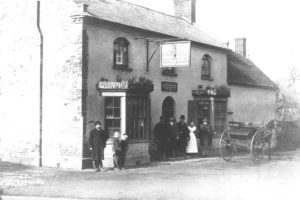
More frivolous activities were taking place at the inn, as well as the important change of owners. Reminiscent of Emmerton’s son and donkey racing to Newport in 1849, in 1907 the same distance was contested between two men. The Bedford Record, 23rd April 1907:
“One of our leading tradesmen, Mr. Henry Sear, of Wood-street, tried conclusions with Mr. J. Coaley, of Wavendon, in a walking match to Newport Pagnell. The start was made from the “Leathern Bottell,” at Wavendon. The distance, somewhere about 5 miles was done in 50 minutes by Coaley, Sear’s time being 53½ minutes. Needless to say there was a good company at the Tavern to witness the start.”
The Hoare family had stayed in close contact with what was happening at Wavendon, even though they were far away. When their only son reached the age of 21, a dinner was held at the “Leathern Bottel” on 19th August 1909, for the tenants to celebrate it, even though the Hoare’s no longer owned the inn. The menu has survived in the archives of Hoare’s Bank. They enjoyed:
Saumon d’Ecosse. Sauce genevoise
Salade aux Concombres
——————————
Quarties d’Agneau Roti
Petits Pois. Pomme risolees
Haricots verts
——————————-
Langue de Boeuf. Poulrdes de Surrey
Canetons d’Aylesbury
Jambon d’York
Salade de laitues
——————————-
Gateau au vin
Trifle aux Fruits
Gelee au citron
——————————
Cheese
Dessert
(Sadly, the young man being thus celebrated, Henry Colt Arthur Hoare, was later killed in action during the horseback charge at El Mughar, Egypt, in 1917, during the First World War. He was an only child and the heir to the whole Stourhead Estate and remaining Hoare lands at Wavendon.)
The Statute Fair coming to the village would have been a highlight of the year. From the Ampthill & District News 4th September 1909: “Wavendon. The annual feast and “statty” was held on Sunday and this week. The field at the “Leather Bottell” was filled with steam motors, ostriches, swing boats, etc. Large crowds were attracted by the dancing at the “Bottell” and “Plough”.”
Whether the ostriches were real or just a showman’s carousel ride, I am not sure…
The next news report about the inn is a tragic one. The Bedfordshire Times and Independent, 11th August 1911 reported that:
“…an inquest was held at Wavendon touching the death of a Bedford mechanic named Robert Walker, who was suffocated by foul air at the bottom of a well which he and others were sinking in Mr. Abercrombie’s yard at the Leather Bottle, Wavendon. The Well, which was forty feet deep, had been tested by lowering a lighted candle which was extinguished. Then a pan of live coals was lowered, it being supposed that this would displace the foul air, which it might be expected to do if there was any through ventilation. However that may be, the Coroner said the man’s life might have been saved if the people on the surface had shown any common courage and presence of mind, but owing to the panic caused by a man who declared that the well was half full of water, no effort was made for a considerable time.”
As far as I know, a candle being extinguished would confirm a lack of oxygen, and lowering in some lit coals would have only increased the carbon monoxide present, but these tests passed for what they considered acceptable Health and Safety precautions of the time.
The last available census to us at present is the one in 1911. The pub was listed as “The Leathern Bottel”, at Church End. The Watts’ children were now grown up, and had their own jobs:
Ernest George Watts, 48, Innkeeper
Sophia Watts, 49
Mary Ellen Watts, 22, Elementary School Teacher, Buckinghamshire Committee
Sarah Elsie Watts, 20, Helper in father’s business
William Ernest George Watts, 18, Railway clerk, goods depot L & NW R Co.
Ernest died just two years later. The Luton Times and Advertiser 20th June 1913:
“Wavendon has lost one of its most esteemed residents through the death of Mr. Ernest G. Watts, who has been landlord of “The Leathern Bottle” for the past twenty-three years.” He had served on the Wavendon Parish Council in 1896.
As was often the case, the landlord’s widow took over the inn. The Northampton Mercury 4th July 1913: “Divisional Petty Sessions. Licensing. – The licence of the Leathern Bottle, Wavendon, was transferred to Mrs. E. Watts, widow of the late landlord.” She was also listed in the 1915 & 1924 Kellys Directories.
Chas. Wells of Bedford photographed their whole estate of pubs in the mid-1920’s. The name of the licensee can be plainly seen on the sign above the door as “Sophia Watts”. [BARS: WL 801/90], but by the late 1920’s, the Watts’ family finally moved on from the inn, as Harold Joseph Loaring is listed in the 1928, 1931 and 1935 Kellys Directories.
Some history of the inn was discussed in the Beds Times of 10th June 1932, prompted by the death of Amos Facer:
“THE LATE MR. FACER. The death occurred on 31st May of Mr. Amos Facer, of 2 Westfield Road, Wakefield. He was born in Wavendon 5th October, 1849 and lived in the village for many years. The Facer family lived here for nearly two centuries. The deceased’s grandfather, who was over ninety when he died, had the “Leathern Bottel” Inn built as a coaching station many years ago. Mr. Amos Facer was the son of John and Elizabeth Facer, and his mother was a member of old Tingewick family; he was the eldest of nine children. Only one sister survives him, Mrs. Elisha Cook, who is the caretaker of St. Mary’s Church. The late Mr. Facer was one of the pioneers of the Primitive Methodist Church in Wavendon and was a faithful and regular worshipper. He was the secretary there until left the village over forty years ago. He and his wife, until a few years ago, always spent their holiday in the village, where he had many friends and relations. His wife was also native of Wavendon. They were married in 1869 and celebrated their diamond wedding three years ago. They then had eight children living, twenty-one grandchildren, and fifteen great-grandchildren. The late Mr. Facer served for over forty years as a guard on the railway, retiring in 1918. He lived a very temperate life and he and his wife were faithful supporters of the Brunswick Wesleyan Church in Wakefield. The funeral took place on Saturday in Wakefield.”
I have not seen the name Facer connected to the Leathern Bottle at all. They were, however, landlords of the Wheatsheaf Inn further up into Church End, from 1851-65. Had the story of being innkeepers of long ago been handed down through the family and become garbled?
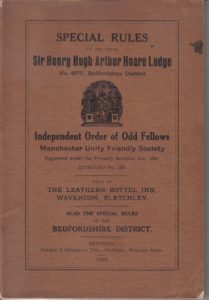
In 1939, with war looming, the National Registration Act was passed, and another listing of all residents was taken. For the Leathern Bottle, there were:
Harold J. Loaring, born 8th August 1894, a Haulage Contractor & Publican
Elizabeth D. Loaring, born 21st October 1899, Unpaid domestic duties
Harold E. Loaring, born 13th April 1920, a sheet metal worker
I don’t know what the relationship was between Loaring and Herbert Butcher, but the inn was given as Butcher’s address at a Coroner’s Inquest after a terrible accident on a boat with two other Naval Ratings in 1941. Details appeared in the Hampshire Telegraph, 19th December 1941. Butcher, a Stoker (First Class), along with Able Seaman Edward Ford and Air Mechanic John Barnett, were crew on a motorboat that had crossed from Portsmouth to Cowes. On arriving, the captain investigated why they had not come out from where they had sheltered under a cover at the front of the boat. It appears the men had pulled a waterproof cover over themselves, but the exhaust fumes from the boat’s engine had been blown back under the cover and they had been asphyxiated by carbon monoxide. The cover was designed to protect the boat from rain when it wasn’t in use, and was not supposed to be used as a crew shelter. A verdict of Accidental Death was recoded. Butcher was brought back to Wavendon for burial. He was the son of Thomas and Sarah Ann Butcher, of Wavendon. His brother Bombardier Frederick John Butcher, of the Royal Artillery, also died on service in World War 2, on 23rd July 1944.
The inn name was mentioned when Loaring was fined £4 in motoring offences, including having inefficient brakes by an Aylesbury policeman, as reported in the Buckinghamshire Advertiser in March 1943.
Post-war, there are very few incidences of the pub in the newspapers so far available on-line, and no easily accessible list to see who held the licence.
Ex-owners Henry Hugh Arthur Hoare and his wife died on the same day in 1947, having already passed their Stourhead House and estate in Wiltshire to the National Trust.
A Mr. Robert Frederick Watson of the Leathern Bottle, Wavendon is mentioned in the London Gazette as having died on 23rd June 1976.
In 1983, a sketch of the pub appeared on one of a set of six Charles Wells beermats, illustrating their various pub names.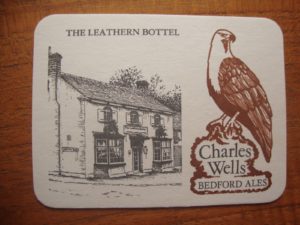
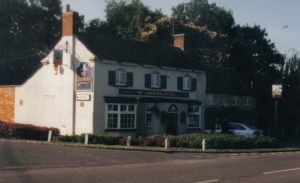
In the early 1990’s, I looked after the pub for a couple of weekends while landlord Frank and Ann Taylor were away. It was a busy food pub by that time, and they had an excellent team working for them, who all knew exactly what they were doing, and really didn’t need me there. I spent most of my time making a fuss of his two elderly dogs!
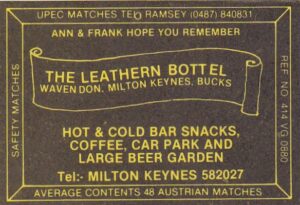
In 2005 the pub closed for refurbishment, and I believe at this time it was sold by Charles Wells to Mitchells & Butlers. It was extensively remodelled and extended, and on re-opening in 2006, the new owners had changed the name to the Wavendon Arms, using the Arms of the Oddfellows Society, who used to meet at the inn, as the new sign.
Landlords (Dates may not be their whole tenure, but when they were definitely there)
1753-1769 Ann Caves
1769-1787 Thomas Holmes
1788-1808 William Holmes
1809-1825 John Bennett
1826 Mattius Mole
1827-1839 William Rogers snr.
1839-1841 William Rogers jnr.
1843-1849 Edward Emmerton
1851-1878 George Abercrombie
1878-1880 William King
1880-1890 Joseph Partridge
1890-1913 Ernest Watts
1913-c.1925 Sophia Watts
1928-1943 Harold Joseph Loaring
???? Belle Jackson
1967-1976 Robert ‘Bob’ Watson
????-1979 John & Jill Morris
1979-1997 Frank & Ann Taylor
1997-2002 Jim Campbell
2002-2007 Tim ?
